|
|
Adams & Westlake "Kero" Lanterns:
I
Of the true short-globe lantern manufacturers, The Adams & Westlake
Company or "A&W" had a dominant share of the market. A&W
introduced its first short globe model, the "#200 Kero " around
1921. The lid of the "#200 Kero" was identical to that of the
company's popular "Reliable" tall-globe
lantern, the version that collectors refer to as having a "three-piece
top". In the mid 1920's, A&W introduced the "#250 Kero" short-globe
lantern, which was substantially the same as the "#200 Kero " but
with some improvements such as a better burner. Around 1930, A&W
released its final short-globe design, simply called the "Kero",
alternately referred to as a "#300" or "#400", depending
on the size of the burner. The "Kero" model was very popular
and still remains in production although for novelty or souvenir use
rather than actual railroad use. In fact, "Kero's" can
be found with "Penn Central" and "Burlington Northern" markings,
both modern railroad names (historically speaking). For more on the Kero,
see A&W Kero's: The Last Stand and A&W
Hertiage Lanterns by Ted Douthitt Jr. and Jerry Gorzoch.
|
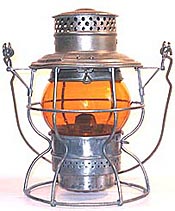 |
|
|
Above Left and Left: Adams & Westlake "#200" short-globe
lantern marked "B. & O. R.R." (Baltimore & Ohio
Railroad) with a clear cast globe. This lantern was the first short
globe model from A&W and was introduced in 1921. The rigid bail
was not "standard" for this model. Above Center: Adams & Westlake "#250" short-globe
lantern marked "N.P. Ry." (Northern Pacific Railway) with
a amber etched globe. The #250 was substantially the same as
the #200, the most notable difference being the burner which was
also marked "No. 250". This model was manufactured from
around 1926 to around 1930 and was succeeded by the "Kero". Above
Right: Adams & Westlake "Kero" short globe
lantern marked "N.P. Ry." (Northern Pacific Railway) with
a clear cast globe. These were very popular lanterns with the
railroads and are currently rather easy to find. More than
100 railroad markings have been documented on Kero's, from the big
Class I's to shortlines. Until the mid '60's or so, A&W marked
them with a date on the bottom, here 2-39 (2nd Quarter, 1939). Below
from left to right: The tops of the #200 Kero, #250 Kero,
and a bare version of the Kero. |
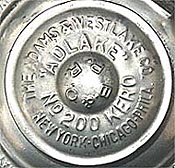 |
|
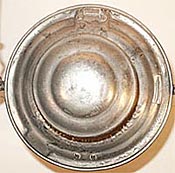 |
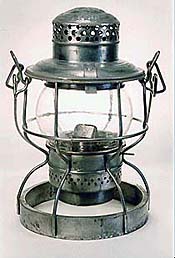 |
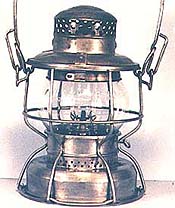 |
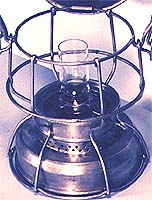 |
| Above Right: Adams & Westlake "Kero" short
globe lantern marked "B.& O. R.R." (Baltimore & Ohio
Railroad) with a clear cast globe and an "engine base" -
the heavy ring at the bottom. This base was intended as extra
weight to keep the lantern on the engine. According to a veteran
of steam locomotive operations, "[steam locomotives] shake,
rumble, vibrate, pitch and buck in all directions. A regular-base
lightweight lantern would likely jump overboard quickly without help
from anybody." The
date on this lantern is 3-63 (3rd Quarter, 1963). Above
Center: Adams & Westlake "Kero" short
globe lantern marked "S.P. Co." (Southern Pacific Company)
with a clear globe and an unusually large fuel fount. The lantern
also has a burner and glass chimney similar to those found in switch
lamps. (See detail Above Right). The purpose of
this lantern is unknown. Collection of (and photo by) David Dunn. |
Examples of short globe lanterns by companies other than Adams & Westlake
are shown on Short Globe Lanterns
Other than Adams & Westlake. In addition, Dietz "Vesta" lanterns
are often classified as short globe lanterns. A discussion and examples
of these can be found on: Dietz "Vesta" Lanterns.
Notes: Information sources are Barrett, Cunningham,
and Dreimiller. |